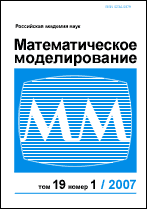|
This article is cited in 4 scientific papers (total in 4 papers)
Simulation of flow near rotating propeller on adaptive unstructured meshes using immersed boundary method
V. O. Tsvetkovaa, I. V. Abalakina, V. G. Bobkova, N. S. Zhdanovaa, T. K. Kozubskayaa, L. N. Kudryavtsevaba
a Keldysh Institute of Applied Mathematics RAS
b Dorodnicyn Computing Centre, Federal Research Center “Computer Science and Control” RAS
Abstract:
The paper presents a method for simulating the flow of a viscous compressible gas around a moving body on a simply connected unstructured mesh which is possible thanks to using the immersed boundary method, and the features of its application for computing the flow around a rotating propeller in two-dimensional formulation. An important part of the method is the adaptation of a moving mesh, that retains its topology, to the surface of the streamlined body. The position and shape of the body are set by the interpolation grid, which stores the distance to the body surface, and the normal to the surface. The technique is used to simulate the flow around a rotating propeller in a flow in twodimensional formulation. The shape of the propeller has areas of high curvature that requires a special approach when adapting to the boundaries. The paper presents the results of simulating the flow around a rotating propeller, as well as a few auxiliary problems considered to verify the developed method.
Keywords:
computational fluid dynamics, unstructured mesh, immersed boundary
method, mesh adaptation, moving mesh, interpolation grid, rotating propeller.
Received: 21.09.2020
Revised: 14.04.2021
Accepted: 19.04.2021
Citation:
V. O. Tsvetkova, I. V. Abalakin, V. G. Bobkov, N. S. Zhdanova, T. K. Kozubskaya, L. N. Kudryavtseva, “Simulation of flow near rotating propeller on adaptive unstructured meshes using immersed boundary method”, Matem. Mod., 33:8 (2021), 59–82; Math. Models Comput. Simul., 14:2 (2022), 224–240
Linking options:
https://www.mathnet.ru/eng/mm4312 https://www.mathnet.ru/eng/mm/v33/i8/p59
|

| Statistics & downloads: |
| Abstract page: | 378 | | Full-text PDF : | 75 | | References: | 67 | | First page: | 17 |
|




 Contact us:
Contact us: Terms of Use
Terms of Use
 Registration to the website
Registration to the website Logotypes
Logotypes








 Citation in format
Citation in format 
